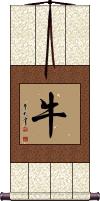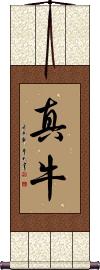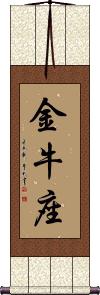Many custom options...
And formats...

Bull in Chinese / Japanese...
Buy a Bull calligraphy wall scroll here!
Personalize your custom “Bull” project by clicking the button next to your favorite “Bull” title below...
Ox / Bull / Cow
Year of the Ox / Bull - Zodiac Sign
牛 is the character for bull, cow, ox, or bovine creature in Chinese, old Korean, and Japanese.
If you were born in the year of the ox/bull/cow, you . . .
Are dedicated to your work.
Are discrete, careful and conscientious.
Value work and family.
Note that in this Chinese character, there is no distinction between bull and cow. All bovine creatures fit into the definition of this character. To distinguish between male and female, another sex-designating character is added in front of this character. Therefore, in China, the energy drink “Red Bull” (Hong Niu) is often translated in the minds of Chinese people as “Red Cow” or even “Red Ox.”
See also our Chinese Zodiac page.
Awesome / Really Cool
Chinese Slang
Taurus Zodiac Symbol / Sign
金牛座 is the Chinese way to write Taurus (bull) from western astrology.
Please note this version is only used in Chinese (see the other version if Japanese is your audience).
See Also: Chinese Zodiac
Taurus Zodiac Symbol / Sign
牡牛座 is the Japanese way to write Taurus (bull) from western astrology.
Please note this version is only used in Japanese (see the other version if Chinese is your audience).
See Also: Chinese Zodiac
Not the results for bull that you were looking for?
Below are some entries from our dictionary that may match your bull search...
| Characters If shown, 2nd row is Simp. Chinese |
Pronunciation Romanization |
Simple Dictionary Definition |
牛 see styles |
niú niu2 niu ushi(p); gyuu; ushi / ushi(p); gyu; ushi うし(P); ぎゅう; ウシ |
More info & calligraphy: Ox / Bull / Cow(1) cattle (Bos taurus); cow; bull; ox; calf; (2) {food} (usu. ぎゅう) (See 牛肉) beef; (3) (ぎゅう only) {astron} (See 二十八宿,玄武・げんぶ・2) Chinese "Ox" constellation (one of the 28 mansions); (surname) Nyū go, gaus; ox, bull, bullock, etc. A term applied to the Buddha Gautama as in 牛王 king of bulls, possibly because of the derivation of his name; the phrase 騎牛來牛 (or 騎牛覔牛) to ride an ox, to seek an ox, means to use the Buddha to find the Buddha. |
赤鬼 see styles |
chì guǐ chi4 gui3 ch`ih kuei chih kuei akaki あかき |
More info & calligraphy: Red DemonThe red demons of purgatory, one with the head of a bull, another with that of a horse, etc. |
牡牛座 see styles |
oushiza / oshiza おうしざ |
More info & calligraphy: Taurus Zodiac Symbol / Sign |
壷 see styles |
tsubosaki つぼさき |
(out-dated or obsolete kana usage) (1) jar; pot; vase; (2) dice cup; (3) depression (i.e. the basin of a waterfall); (4) (archaism) target (when aiming an arrow); (5) (kana only) (figurative) bull's-eye; (6) (kana only) key point (of a conversation, etc.); (7) (kana only) acupuncture point; moxibustion point; (8) (kana only) nodes on a fingerboard (of a shamisen, etc.); hu (ancient Chinese vessel shaped like a vase, usually used to store alcohol); (surname) Tsubosaki |
壺 壶 see styles |
hú hu2 hu tsubosaki つぼさき |
pot; classifier for bottled liquid (out-dated or obsolete kana usage) (1) jar; pot; vase; (2) dice cup; (3) depression (i.e. the basin of a waterfall); (4) (archaism) target (when aiming an arrow); (5) (kana only) (figurative) bull's-eye; (6) (kana only) key point (of a conversation, etc.); (7) (kana only) acupuncture point; moxibustion point; (8) (kana only) nodes on a fingerboard (of a shamisen, etc.); hu (ancient Chinese vessel shaped like a vase, usually used to store alcohol); (surname) Tsubosaki |
壼 壸 see styles |
kǔn kun3 k`un kun tsubo つぼ tsuho つほ tsufu つふ |
palace corridor; fig. women's quarters; women (irregular kanji usage) (1) jar; pot; vase; (2) dice cup; (3) depression (i.e. the basin of a waterfall); (4) (archaism) target (when aiming an arrow); (5) (kana only) (figurative) bull's-eye; (6) (kana only) key point (of a conversation, etc.); (7) (kana only) acupuncture point; moxibustion point; (8) (kana only) nodes on a fingerboard (of a shamisen, etc.); (irregular kanji usage) (out-dated or obsolete kana usage) (1) jar; pot; vase; (2) dice cup; (3) depression (i.e. the basin of a waterfall); (4) (archaism) target (when aiming an arrow); (5) (kana only) (figurative) bull's-eye; (6) (kana only) key point (of a conversation, etc.); (7) (kana only) acupuncture point; moxibustion point; (8) (kana only) nodes on a fingerboard (of a shamisen, etc.) |
牤 see styles |
māng mang1 mang |
bull; see 牤牛[mang1 niu2] |
特 see styles |
tè te4 t`e te toku |
special; unique; distinguished; especially; unusual; very; abbr. for 特克斯[te4 ke4 si1], tex A bull, stallion; outstanding, special, alone. |
犍 see styles |
qián qian2 ch`ien chien kon |
used in 犍為|犍为[Qian2 wei4], a country in Sichuan A gelded bull, an ox; a creature half man, half leopard. |
犗 see styles |
jiè jie4 chieh |
castrated bull; bullock |
的 see styles |
dì di4 ti yukuha ゆくは |
(bound form) bull's-eye; target (1) mark; target; (2) object; subject; focus; (3) point (e.g. of argument); (personal name) Yukuha main point |
鵙 see styles |
jú ju2 chü mozu もず |
a shrike (1) (kana only) shrike (any bird of family Laniidae); (2) bull-headed shrike (Lanius bucephalus); butcher bird |
ウシ see styles |
uji ウジ |
(1) cattle (Bos taurus); cow; bull; ox; calf; (2) beef; (personal name) Uzi |
ツボ see styles |
tsubo ツボ |
(1) jar; pot; vase; (2) dice cup; (3) depression (i.e. the basin of a waterfall); (4) (archaism) target (when aiming an arrow); (5) (kana only) (figurative) bull's-eye; (6) (kana only) key point (of a conversation, etc.); (7) (kana only) acupuncture point; moxibustion point; (8) (kana only) nodes on a fingerboard (of a shamisen, etc.) |
丑牛 see styles |
chǒu niú chou3 niu2 ch`ou niu chou niu |
Year 2, year of the Bull or Ox (e.g. 2009) |
公牛 see styles |
gōng niú gong1 niu2 kung niu |
bull |
十二 see styles |
shí èr shi2 er4 shih erh tooji とおじ |
twelve; 12 12; twelve; (given name) Tooji dvātriṃśa. Thirty-two. 三十二應 (or 三十二身) The thirty-two forms of Guanyin, and of Puxian, ranging from that of a Buddha to that of a man, a maid, a rakṣas; similar to the thirty-three forms named in the Lotus Sūtra. 三十二相三十二大人相 dvātriṃśadvaralakṣaṇa. The thirty-two lakṣaṇas, or physical marks of a cakravartī, or 'wheel-king', especially of the Buddha, i. e. level feet, thousand-spoke wheel-sign on feet, long slender fingers, pliant hands and feet, toes and fingers finely webbed, full-sized heels, arched insteps, thighs like a royal stag, hands reaching below the knees well-retracted male organ, height and stretch of arms equal, every hair-root dark coloured, body hair graceful and curly, golden-hued body, a 10 ft. halo around him, soft smooth skin, the 七處, i. e. two soles, two palms, two shoulders, and crown well rounded, below the armpits well-filled, lion-shaped body, erect, full shoulders, forty teeth, teeth white even and close, the four canine teeth pure white, lion-jawed, saliva improving the taste of all food, tongue long and broad, voice deep and resonant, eyes deep blue, eyelashes like a royal bull, a white ūrnā or curl between the eyebrows emitting light, an uṣṇīṣa or fleshy protuberance on the crown. These are from the 三藏法數 48, with which the 智度論 4, 涅盤經 28, 中阿含經, 三十ニ相經 generally agree. The 無量義經 has a different list. 三十二相經 The eleventh chapter of the 阿含經. 三十二相經願 The twenty-first of Amitābha's vows, v. 無量壽經. 三十三 trayastriṃśat. Thirty-three. 三十三天忉利天; 憺梨天, 多羅夜登陵舍; 憺利夜登陵奢; 憺利耶憺利奢 Trayastriṃśas. The Indra heaven, the second of the six heavens of form. Its capital is situated on the summit of Mt. Sumeru, where Indra rules over his thirty-two devas, who reside on thirty-two peaks of Sumeru, eight in each of the four directons. Indra's capital is called 殊勝 Sudarśana, 喜見城 Joy-view city. Its people are a yojana in height, each one's clothing weighs 六鐵 (1; 4 oz. ), and they live 1, 000 years, a day and night being equal to 100 earthly years. Eitel says Indra's heaven 'tallies in all its details with the Svarga of Brahminic mythology' and suggests that 'the whole myth may have an astronomical meaning', or be connected, with 'the atmosphere with its phenomena, which strengthens Koeppen's hypothesis explaining the number thirty-three as referring to the eight Vasus, eleven Rudras, twelve Ādityas, and two Aśvins of Vedic mythology'. In his palace called Vaijayanta 'Indra is enthroned with 1, 000 eyes with four arms grasping the vajra. There he revels in numberless sensual pleasures together with his wife Śacī... and with 119, 000 concubines with whom he associates by means of transformation'.; dvādaśa, twelve. |
升市 see styles |
shēng shì sheng1 shi4 sheng shih masuichi ますいち |
rising prices; bull market (surname) Masuichi |
印璽 印玺 see styles |
yìn xǐ yin4 xi3 yin hsi inji いんじ |
official seal; imperial or royal seal; papal bull imperial seal |
図星 see styles |
zuboshi ずぼし |
bull's-eye; the mark |
廃牛 see styles |
haigyuu / haigyu はいぎゅう |
(abbreviation) (See 廃用牛) culled cow; spent cow; spent bull |
教書 教书 see styles |
jiāo shū jiao1 shu1 chiao shu kyousho / kyosho きょうしょ |
to work as a teacher; to teach (in a school) (1) (See 一般教書) message (delivered by the US president or a state governor); address; (2) (papal) bull; decree; (3) (obsolete) (See 教科書) textbook |
暴牛 see styles |
abareushi あばれうし |
restive bull (esp. in bull riding) |
正鵠 see styles |
seikoku; seikou / sekoku; seko せいこく; せいこう |
bull's-eye; mark; point |
牛市 see styles |
niú shì niu2 shi4 niu shih ushiichi / ushichi うしいち |
bull market (place-name) Ushiichi |
牛年 see styles |
niú nián niu2 nian2 niu nien |
Year of the Ox or Bull (e.g. 2009) |
牛跡 牛迹 see styles |
niú jī niu2 ji1 niu chi goshaku |
Ox-tracks, i. e. the teaching of a Buddha the 牛王 royal bull. |
牛鞭 see styles |
niú biān niu2 bian1 niu pien |
pizzle; bull's penis (served as food) |
牛鮫 see styles |
ushizame; ushizame うしざめ; ウシザメ |
(kana only) (See 大目白鮫・おおめじろざめ) bull shark (Carcharhinus leucas) |
牡牛 see styles |
mǔ niú mu3 niu2 mu niu oushi / oshi おうし |
bull bull; ox; steer |
Click here for more bull results from our dictionary
The following table may be helpful for those studying Chinese or Japanese...
| Title | Characters | Romaji (Romanized Japanese) | Various forms of Romanized Chinese | |
| Ox Bull Cow | 牛 | ushi | niú / niu2 / niu | |
| Awesome Really Cool | 真牛 | zhēn niú / zhen1 niu2 / zhen niu / zhenniu | chen niu / chenniu | |
| Taurus Zodiac Symbol Sign | 金牛座 | jīn niú zuò jin1 niu2 zuo4 jin niu zuo jinniuzuo | chin niu tso chinniutso |
|
| Taurus Zodiac Symbol Sign | 牡牛座 | oushi-za / oshi-za | ||
Successful Chinese Character and Japanese Kanji calligraphy searches within the last few hours...







